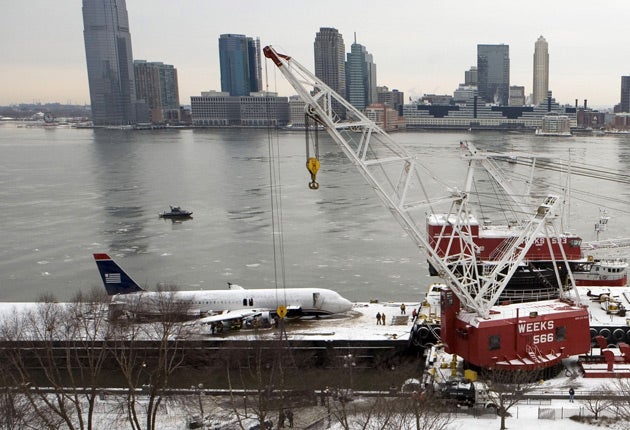Black box confirms plane lost both engines

Your support helps us to tell the story
From reproductive rights to climate change to Big Tech, The Independent is on the ground when the story is developing. Whether it's investigating the financials of Elon Musk's pro-Trump PAC or producing our latest documentary, 'The A Word', which shines a light on the American women fighting for reproductive rights, we know how important it is to parse out the facts from the messaging.
At such a critical moment in US history, we need reporters on the ground. Your donation allows us to keep sending journalists to speak to both sides of the story.
The Independent is trusted by Americans across the entire political spectrum. And unlike many other quality news outlets, we choose not to lock Americans out of our reporting and analysis with paywalls. We believe quality journalism should be available to everyone, paid for by those who can afford it.
Your support makes all the difference.The black boxes recovered from the US Airways jetliner that safely splashed down in the Hudson River last week captured thumping sounds, the sudden loss of engine power and the pilot's calm mayday request, evidence that seems to back up the crew's account of hitting a flock of birds shortly after take off.
The pilot, Chesley "Sully" Sullenberger, credited with helping save the lives of all 155 people aboard, reports that the plane has hit birds and lost both engines shortly after investigators heard "the sound of thumps and a rapid decrease in engine sounds," National Transportation Safety Board member Kitty Higgins said.
Sullenberger then discussed alternate landings at New Jersey airports before deciding to attempt a river landing, she said. Ninety seconds before ditching the plane, he told passengers to "brace for impact" and informs controllers "they will be in the Hudson River," Higgins said.
The dispatches on the cockpit voice recorder were described as "a very calm, collected exercise," Robert Benzon, a veteran safety board investigator, said Sunday.
Said Higgins: "It was very matter of fact."
In Washington, D.C., safety board spokesman Peter Knudson said preliminary indications from radar data of the plane's take off Thursday from LaGuardia Airport "did not show any targets" that might be birds. But investigators will keep looking, he said.
"We are going to go and get all the electronic data necessary to get a complete picture of what was on his screen. It's possible there was more being displayed than we initially understood. We just don't know definitively at this point — we don't know exactly what was shown on that radar screen," Knudson said.
Sullenberger, who has so far not publicly talked about the crash, has been invited to attend President-elect Barack Obama's inauguration on Tuesday, according to the mayor of his hometown, Danville, Calif. An Obama aide said Sunday evening the family had been invited, speaking on condition of anonymity because details were still being worked out.
Stephen Bradford, president of the U.S. Airline Pilots Association, said he asked Sullenberger not to engage in any media activities because the pilots association has "interested party" status with the NTSB, which allows it to participate in the investigation.
Higgins heaped praises on Sullenberger and the flight crew, noting they all had 20 or more years experience and were trained to do their jobs.
"Miracles happen because a lot of everyday things happen for years and years and years," she said. "These people knew what they were supposed to do and they did it and as a result, nobody lost their life."
Under a heavy snowfall Sunday night, tugboats pulled the barge carrying the Airbus A320 from a seawall a few blocks from the World Trade Center site on a 90-minute trip to the Weeks Marina in Jersey City, N.J. Investigators on Monday want to look more closely at the cockpit, the attached right engine, and the interior of the cabin, Higgins said.
Already investigators have seen significant damage to the tail and to compartments at the bottom of the plane that opened on impact. The right engine was severely dented but its fan blades were intact, Benzon said.
The search for the plane's missing left engine is suspended until Tuesday because ice floes in the river make it too dangerous to put divers or special sonar equipment in the water, Higgins said.
A senior NTSB official said the probe may ultimately focus more on what went right than what went wrong on Thursday.
"This accident and this investigation are going to be studied for years and years and years," said Robert Benzon, a veteran National Transportation Safety Board investigators. "Why did everything work so well?
"We need to know that so we can apply it to other phases of aviation, other aircraft, perhaps newer aircraft. It's going to be fun."
The area where the broken plane was moored in New York was closed to the public Sunday, but it attracted hundreds of residents and tourists, who snapped pictures of the plane wreckage.
Kelsey Higginbotham, a 20-year-old student at East Tennessee State University, peered at the crippled aircraft Sunday from behind police barricades.
She and a friend had been to Times Square, Central Park and the site of the World Trade Center, where nearly 2,800 people were killed in the Sept. 11 attacks. She said she was struck by the contrast between one disaster in which so many people died and another in which everyone survived.
"It's a miracle," she said. "I guess New Yorkers can't take any more tragedy."
Associated Press writer Victor Epstein in Jersey City, N.J.; Harry Weber in Atlanta; Jason Dearen in San Francisco; and Lou Kesten and Joan Lowy in Washington, D.C., contributed to this report.
Subscribe to Independent Premium to bookmark this article
Want to bookmark your favourite articles and stories to read or reference later? Start your Independent Premium subscription today.
Join our commenting forum
Join thought-provoking conversations, follow other Independent readers and see their replies
Comments